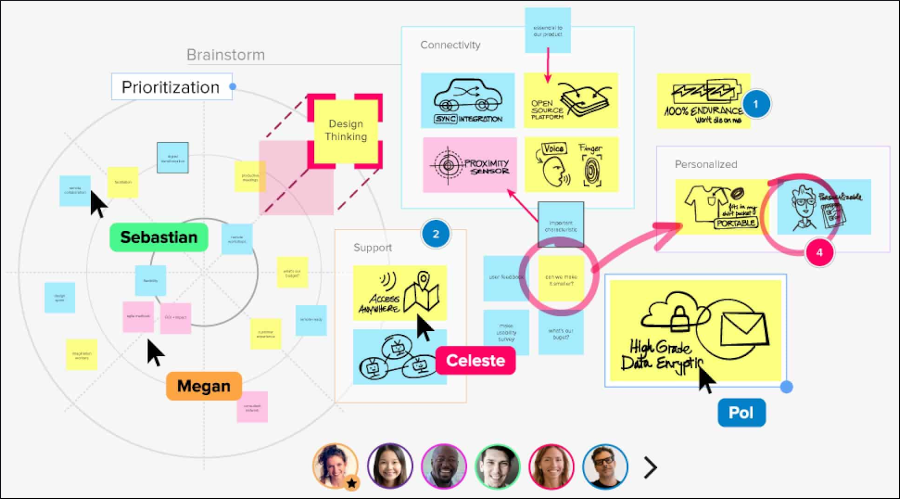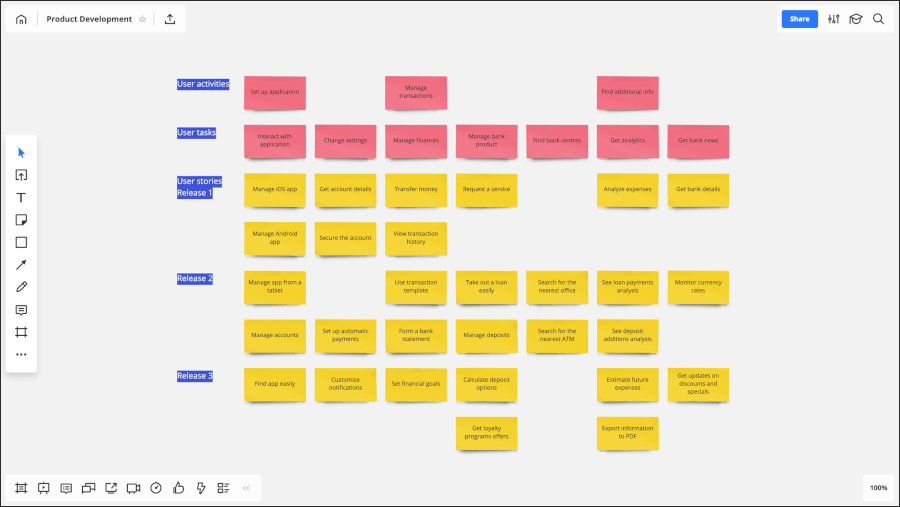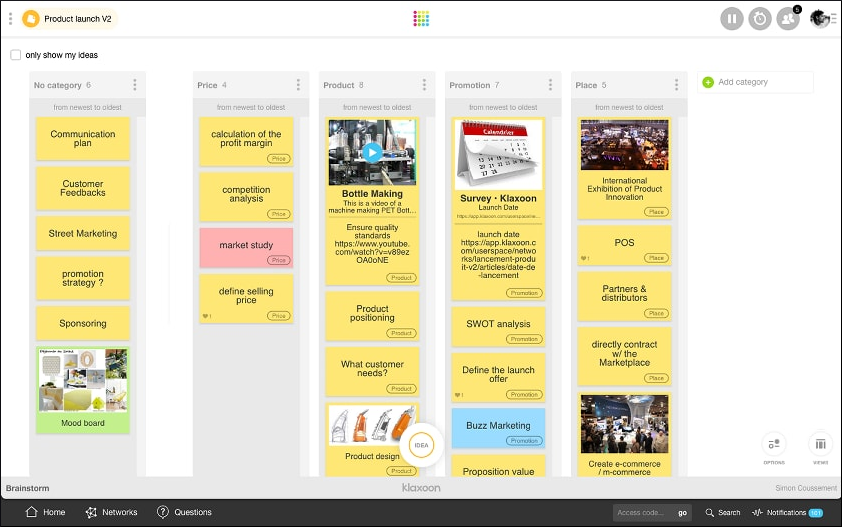
Each day, the news is filled with stories of organizations that have decided to let their employees, students and constituents work remotely, to help blunt the spread of the coronavirus. Visual collaboration tools are a class of business applications that are ideally suited to this trend.
I’m now in the process of interviewing many of the developers of visual collaboration tools to get their take on the current pandemic, evolving patterns in remote work and how organizations are empowering their distributed teams to remain productive until this global contagion dies down.
But what are visual collaboration tools? How are remote teams using them today? And how you can benefit from them? Here’s an overview of this technology, presented in the form of a list of FAQs:
What are visual collaboration tools? What do they do?
The easiest way to envision what visual collaboration tools do is to picture a digital whiteboard. Imagine a virtual workspace that can contain many types of objects – such as sticky notes, images, a chat window, digitized drawings and much more. Imagine a background layer on that digital canvas that displays templates for organizing your team’s input in meaningful ways. And then imagine everyone on your team being able to contribute to this shared workspace at the same time.

Visual collaboration tools enable teams to:
- Brainstorm and plan projects
- Create centralized hubs or collections of information
- View the big picture and the details
- Run very efficient meetings
- Capture and organize capture ideas quickly
- Share and collaborate on a variety of digital content
- Set priorities and tasks
- Make better decisions, faster
- Plan, execute and monitor the progress of projects
- Analyze and reach clarity on complex problems and ideas
What’s the difference between real-time and asynchronous collaboration?
Visual collaboration tools enable team members to work together in two main ways:
Real-time collaboration works like it sounds – everyone is online at the same time, contributing ideas, comments and content to the shared workspace.
Asynchronous collaboration happens when people DON’T meet online at the same time. They login when it’s convenient for them and contribute their thoughts, ideas, comments and content to the shared workspace. Teams that are globally distributed often work this way, because the time zones they’re working in are very different. While you’re sleeping, they’re working and vice versa.
Visual collaboration tools enable both types of collaboration, providing a high degree of flexibility to distributed teams.
What are the most common features of visual collaboration tools?
Visual collaboration tools represent everything from a simple digital whiteboard that multiple people can draw on ato sophisticated enterprise tools that support a dazzling array of work tasks and content.

Here is a roundup of the features and capabilities of some of the higher-end applications:
- Customizable templates – which enable teams to get started, work faster and build workflows to guide their efforts
- Voting – useful for having teams evaluate the ideas they’ve brainstormed
- A timer – to set time limits for brainstorming
- Commenting on elements within the workspace – useful for sharing feedback and approvals
- Prioritizing tasks
- Embedded discussion capabilities
- Draw on touch-sensitive screens – for fast idea capture
- Mind mapping and diagramming
- Digitize physical sticky notes – bring them into your environment to add to your brainstorms and discussions
- Integrate with other tools and workflows, such as Jira, Azure, Confluence, Trello and Google Docs
- Add a variety of external content to your digital workspace, including text, files, images, videos and more
- Collaborate on a variety of devices, from smartphones to large touch-sensitive screens like the Microsoft Surface Hub
- Configurable sharing options, so you can collaborate with people inside and outside of your organization – securely
How do visual collaboration tools enhance work?
By providing a digital canvas where everyone can contribute, visual collaboration tools help to democratize work. Introverts don’t need to worry about being put on the spot to share their thoughts in a face-to-face team meeting. This semi-anonymity makes them more likely to share their best ideas and become active participants in a shared digital workspace.
Because multiple people can contribute to the workspace at the same time, meetings and projects tend to move faster. Team members don’t have to wait for one person to share their thoughts. Collaboration sessions get accelerated to the speed of thought!
What types of projects and activities do they enable?
The number of business use cases of visual collaboration tools is quite large. Here are some of the most commonly ones cited by their developers:
Product development: User story and customer journey maps, workflows, defining product requirements, interactive design and storytelling and create/present proofs of concept
Agile teams: Run scrums – sprint planning and retrospectives
UX research and design: Build out customer journey maps, user personas and empathy maps, as well as service design blueprints
Innovation and ideation: Mind maps, affinity maps, 5 Why exercises
Strategy development: Business model canvas, kanban, value chain analyses
Situational awareness: Keep track of up-to-the-minute inputs from multiple sources, make better-informed decisions, crisis management
Marketing: Speed the process of creating and storyboarding messaging, reviewing and approving proofs
Coaching and teaching: Conduct online workshops and training, run a small online conference, engage in group learning and digital team-building, tutor others
How are visual collaboration tools different than Slack, Zoom and other popular collaboration tools?
Everyone can contribute simultaneously in a visual collaboration tool. With tools like Zoom and GoToMeeting, only one person can share their screen at a time. There’s not a persistent workspace where everyone can contribute, comment and actively participate.
How are these tools different than a digital whiteboard?
Visual collaboration tools have an infinite,, zoomable canvas. Work can expand beyond the limits of a single screen or sheet of paper. There’s no more need to rip a sheet of paper full of notes from a whiteboard and stick it to the wall. Or have a team member photograph a whiteboard full of scrawled ideas before the facilitator must erase it to make room for more thinking.
Conclusion
Under today’s unique circumstances, visual collaboration tools are an ideal platform for remote teams to continue working productively and effectively. While these tools weren’t invented to take advantage of the coronavirus outbreak, they are definitely the right tool at the right time, and have the potential to accelerate a trend in remote work that was already underway.
Watch for more details in my next article, in which I will share excerpts from my conversations with the developers of these tools. In these conversations, they will share what they’re seeing and hearing, and what their customers are telling them about the impact of the coronavirus on their projects and operations.
NEW Report
 My new report highlights visual collaboration tools that enable your teams to think, plan, create and take action efficiently while working remotely. Download it now (no registration required).
My new report highlights visual collaboration tools that enable your teams to think, plan, create and take action efficiently while working remotely. Download it now (no registration required).
Additional resources
Visual collaboration tools: How they empower remote teams to excel
15 ways visual collaboration tools supercharge remote brainstorming
23 applications of visual brainstorming and collaboration tools


Leave a Reply